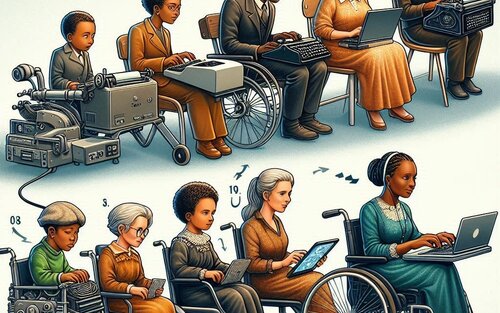From ancient aids like canes and ear trumpets to today’s advanced prosthetics and smart devices, the journey of assistive technology is a testament to human ingenuity and compassion.
Early Beginnings: Ancient Aids
The roots of assistive technology can be traced back to ancient civilizations. In Egypt and Greece, simple tools like canes were used to assist with mobility for those who had difficulty walking. Meanwhile, in Rome and Egypt, rudimentary prosthetic limbs made from materials like wood and metal were crafted to replace lost limbs.
The Birth of Braille: A Revolutionary Communication Tool
One of the most significant advancements in assistive technology came in 1824 with the invention of Braille by Louis Braille. Louis, who lost his sight as a child, developed the Braille system—a tactile writing system using raised dots representing letters and numbers. This breakthrough allowed blind individuals to read and write independently, profoundly changing education and communication for the visually impaired.
The Evolution of Hearing Aids
Early attempts to assist those with hearing impairments involved devices like ear trumpets, which captured sound and directed it into the ear. In the 20th century, electric hearing aids emerged, starting with bulky models that amplified sound using vacuum tubes. The invention of the transistor in the 1950s led to smaller, more efficient hearing aids, marking a significant leap in technology for the hearing impaired.
From Wheelchairs to Mobility Aids
The history of wheelchairs dates back centuries, with evidence of basic designs found in ancient China and Greece. However, it was not until the 20th century that significant advancements were made. The introduction of lightweight materials and motorized options in the mid-20th century revolutionized mobility aids, providing greater independence and mobility for people with physical disabilities.
Computer Accessibility: Opening Doors to Communication
The advent of computers brought new opportunities for people with disabilities. Screen readers, developed in the 1970s and 1980s, allowed blind individuals to access digital content by converting text into speech or Braille. Similarly, advancements in voice recognition technology enabled those with limited mobility to control computers and devices using spoken commands.
Modern Innovations: Smart Devices and Beyond
Today, assistive technology continues to evolve at a rapid pace. Smartphones and tablets offer accessibility features such as screen magnification, voice control, and text-to-speech capabilities, making everyday tasks more manageable for users with disabilities. Prosthetics have become increasingly advanced, with some incorporating robotics and artificial intelligence to mimic natural limb movements.
The Future of Assistive Technology
Looking ahead, the future of assistive technology holds promise for even greater advancements. Emerging technologies like brain-computer interfaces (BCIs) show potential in enabling direct communication between the brain and external devices, offering new possibilities for individuals with severe disabilities.
Empowering Lives Through Innovation
In conclusion, the history of assistive technology is a story of resilience, innovation, and compassion. What began with simple aids has evolved into a diverse array of technologies that empower individuals with disabilities to live more independently and participate fully in society. As technology continues to progress, so too will the opportunities for enhancing the quality of life for people of all abilities.
Assistive technology is not just about tools—it’s about breaking barriers, expanding opportunities, and ensuring that everyone, regardless of their abilities, can thrive and contribute to a brighter future.

